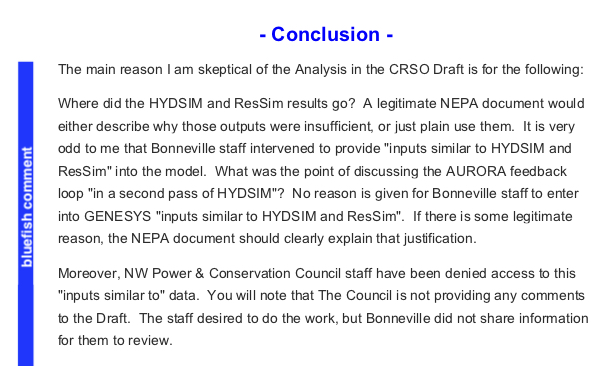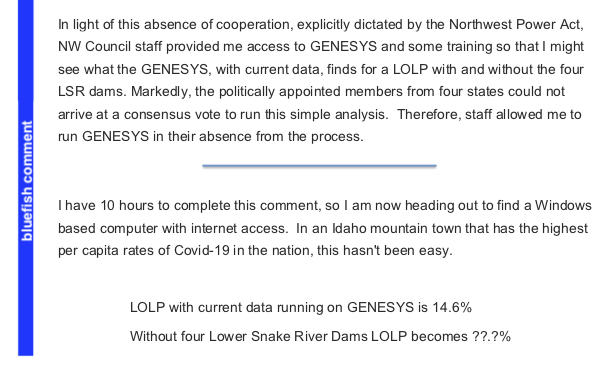Columbia River System Operations
Comment & Response
of bluefish.org
Cover Letter
----------------------------
Conservation
Coal
Carbon Sequestration
----------------------------
Irrigation
Barging Wheat
Barging Salmon and Steelhead
----------------------------
Survival of Salmon and Steelhead
Juvenile Survival through Hydrosystem
Water Temperature
Predation by Birds
Ocean Conditions
----------------------------
Greenhouse Gases
An Adequate Power Supply
An Economic Power Supply
A Reliable Power Supply
An Efficient Power Supply
----------------------------
Potatoes, Apples & Grapes
Petroleum to Pasco
----------------------------
Orca and Idaho's Chinook
Flex Spill to 125% TDG
Breach Lower Snake River Embankments
----------------------------
Social Effects
Cultural Resources
Environmental Justice
----------------------------
Conclusion

Federal Response:
Hydroregulation (regulating water) is the process planners and operators use to make decisions about routing water through a series of dams in a river system. Computer hydroregulation modeling is used to simulate operations for the system of dams that operate for multiple purposes, including flood risk management, hydropower, irrigation, navigation, recreation, water supply, and fish and wildlife purposes. Two hydroregulation models were used to simulate operations in the basin in support of the Hydraulics and Hydrology analysis: Hydro System Simulator (HYDSIM) and Hydrologic Engineering Center Reservoir System Simulation (ResSim) software. The models mesh together through multiple steps to simulate operations in the Columbia River Basin. More information on these models is available in Section 3.2 and in Appendix B of the Draft EIS.AURORA is a production cost model that uses loads and resource projections to calculate wholesale markets for the West. The model estimates how much power can be sold into the wholesale market and estimates the related prices. Appendix I, Hydroregulation, and Appendix J, Hydropower, provide detailed information on this model. This analysis relies on the hydroregulation modeling.
To analyze the power system reliability Bonneville uses the GENeration Evaluation SYStem (GENESYS) model, which simulates regional power generation and demand.
Non-response -- bluefish counter response:
The federal response (above) has completely avoided any attempt at answering my concern. No explanation, whatsoever, has been given as to why Bonneville staff intervened in the middle of what was designed to be a seamless process.With no response given as to why "inputs similar to HYDSIM and ResSim" were used, bluefish's skepticism of the results is only heightened. Why not answer the question or repudiate the suggestion that the results were fudged? Avoiding the question only adds to the suspicion that the Executive Summary authors falsified the CRSO results to support their predetermined conclusion.
Following a strong suspicion of maleficence, a FOIA request was submitted by bluefish, a request that was unexplainably stalled, then belatedly fulfilled one day before the Final NEPA document was released. Moreover, the date of the FOIA office response was one month earlier than when it was delivered to bluefish. This is not standard procedure and bluefish is continuing to seek explanation for this lapse in communication, but that is another issue.
The FOIA request that was eventually received brought further questions that are yet to be answered. The requested data of the GENESYS modeling results were to show that the Multi-Objectives' "Resource Replacement Portfolios" sufficiently restored the Loss of Load Probability (LOLP) to match that of the No Action Alternative. But lo and behold, the LOLP for MO4 missed that mark: 7.2 percent is greater than 6.6 percent.
Importantly, MO4 lies at the heart of the CRSO Preferred Alternative, but the FOIA data reveals that it's "Conventional Resource Replacement Portfolio" brings the LOLP only down to 7.2%, which is well above the LOLP of 6.6 percent that is promised in the CRSO document. (Before the "Resource Replacement Portfolio, MO4's LOLP is modeled to be 30% reported in Appendix H Table 2-10 on page H-2-27).
Now we have doubled the concern. When bluefish public comments pointed out, with suspicion, that "inputs similar to Hydsim and ResSim" interceded into the otherwise seamless process, the Federal Response to bluefish (above) completely avoided answering this concern. Then, with this FOIA request in hand, we learn that even more deceit is being concealed. A legitimate NEPA analysis is honest. This CRSO is not, and in multiple ways it fails to pass the standard of legitimacy.
Laying at the heart of the CRSO's Preferred Alternative, MO4 does not restore the LOLP to match that of the No Action Alternative, in spite of this being a necessary condition repeatedly stated in the NEPA document.

Federal Response:
Bonneville staff have the expertise to run the GENESYS model and describe its outputs for the CRSO EIS. Bonneville has worked with the Northwest Power and Conservation Council (Council) on developing the model for many years. For areas of the CRSO EIS power analysis where Bonneville staff did not have expertise, Bonneville hired consultants; however, for the GENESYS model, this expertise is housed within Bonneville.The Council received periodic updates on the CRSO EIS NEPA process similar to the general public. Since the Council is not a Federal, Tribal, state or local agency, it could not serve as a cooperating agency under NEPA. The Council received the Draft EIS when it was available for public review.
bluefish counter response:
Forty-five days is an unusually short period of time for anyone to review an 8,000 page document and provide an intelligible comment with useful feedback.At it's outset, the Northwest Power & Conservation Council was to be a trusted, indpendent arbiter, that must at all times "consider protection, mitigation, and enhancement of fish and wildlife and related spawning grounds and habitat, including sufficient quantities and qualities of flows for successful migration, survival and propagation of anadromous fish." Unfortunately, overtime, it has been corrupted with some Council members taking their interests, or their intepretation of their state's interest, to usurp the interests of that dictated by their founding Northwest Power Act of 1980.
If you feel this charge is too strong, you need look no further than Councilman Jim Yost's testimony to Congress. This testimony, and especially its closing sentence, brought criticism from the more open-minded fellow Councilmen that were serving alongside him at the time. If that is not convincing enough, one need only listen to the monthly public meetings to hear Mr. Yost express his viewpoints, and then decide for yourself if the Northwest Power Act purposes are being held at the forefront of his mind. As for the other members, I will withhold judgement and allow you to judge their prejudices and leanings away from "equitable treatment for fish" on you own, while noticing that some of the membership is exemplary in their integrity.
Bringing this attention to the NW Power & Conservation Council is to provide background and understanding of why the Council will most likely not be considering Remove Snake River Embankments in their upcoming Eighth Power Plan. Having devoted a Chapter of both their Sixth and Seventh Power Plans to a look at Lower Snake River dam breaching, it is strikingly odd that their Eighth Power Plan will be completely ignoring that topic. At their monthly meeting, bluefish will continue to provide public comment with encouragement, but politics and special interests in favor of hydropower will most likely rule the day. Funny, huh? Or sad? Without a look at this important topic, the Council will quite obviously be shirking its responsibilities, mandated by the Northwest Power Act of 1980, to seek "equitable treatment of fish and wildlife" alongside the region's power planning mandate.